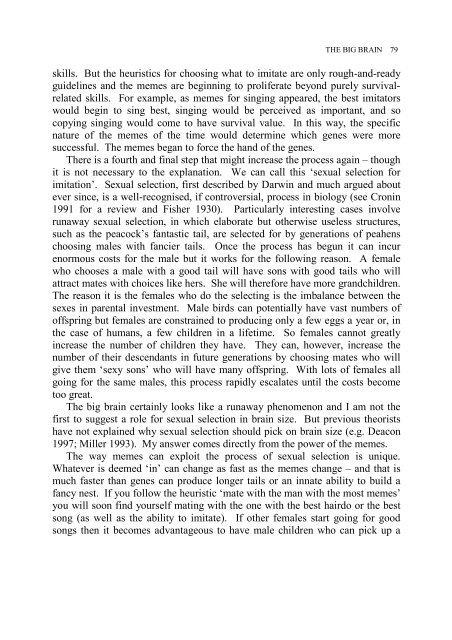The Meme Machine
TheMemeMachine1999
TheMemeMachine1999
- No tags were found...
You also want an ePaper? Increase the reach of your titles
YUMPU automatically turns print PDFs into web optimized ePapers that Google loves.
THE BIG BRAIN 79<br />
skills. But the heuristics for choosing what to imitate are only rough-and-ready<br />
guidelines and the memes are beginning to proliferate beyond purely survivalrelated<br />
skills. For example, as memes for singing appeared, the best imitators<br />
would begin to sing best, singing would be perceived as important, and so<br />
copying singing would come to have survival value. In this way, the specific<br />
nature of the memes of the time would determine which genes were more<br />
successful. <strong>The</strong> memes began to force the hand of the genes.<br />
<strong>The</strong>re is a fourth and final step that might increase the process again – though<br />
it is not necessary to the explanation. We can call this ‘sexual selection for<br />
imitation’. Sexual selection, first described by Darwin and much argued about<br />
ever since, is a well-recognised, if controversial, process in biology (see Cronin<br />
1991 for a review and Fisher 1930). Particularly interesting cases involve<br />
runaway sexual selection, in which elaborate but otherwise useless structures,<br />
such as the peacock’s fantastic tail, are selected for by generations of peahens<br />
choosing males with fancier tails. Once the process has begun it can incur<br />
enormous costs for the male but it works for the following reason. A female<br />
who chooses a male with a good tail will have sons with good tails who will<br />
attract mates with choices like hers. She will therefore have more grandchildren.<br />
<strong>The</strong> reason it is the females who do the selecting is the imbalance between the<br />
sexes in parental investment. Male birds can potentially have vast numbers of<br />
offspring but females are constrained to producing only a few eggs a year or, in<br />
the case of humans, a few children in a lifetime. So females cannot greatly<br />
increase the number of children they have. <strong>The</strong>y can, however, increase the<br />
number of their descendants in future generations by choosing mates who will<br />
give them ‘sexy sons’ who will have many offspring. With lots of females all<br />
going for the same males, this process rapidly escalates until the costs become<br />
too great.<br />
<strong>The</strong> big brain certainly looks like a runaway phenomenon and I am not the<br />
first to suggest a role for sexual selection in brain size. But previous theorists<br />
have not explained why sexual selection should pick on brain size (e.g. Deacon<br />
1997; Miller 1993). My answer comes directly from the power of the memes.<br />
<strong>The</strong> way memes can exploit the process of sexual selection is unique.<br />
Whatever is deemed ‘in’ can change as fast as the memes change – and that is<br />
much faster than genes can produce longer tails or an innate ability to build a<br />
fancy nest. If you follow the heuristic ‘mate with the man with the most memes’<br />
you will soon find yourself mating with the one with the best hairdo or the best<br />
song (as well as the ability to imitate). If other females start going for good<br />
songs then it becomes advantageous to have male children who can pick up a



